Overview

There are many types and styles of hoods to choose from with different feature packages and price levels. If you are building a new kitchen or extensively renovating your existing one, consulting your builder or contractor can help you choose the right power level and design for your needs. An under-powered range hood won't effectively remove smoke and odors from your kitchen, and an over-powered hood won't be a good use of your money!
Hoods will range in price from $49 to $1,200 and more. You don't have to spend much over $400 to get a hood that will do a great job in most kitchens without breaking the bank. Most customers will spend between $159 and $599 for a hood for their home, but you can spend a lot more depending on your needs and your budget.
First, we'll discuss the differences between ductless or recirculating range hoods and ducted hoods.
Re-Circulating vs Ducted Ventilation
What's the Deal with Ductless?
There are alternatives to venting outdoors which can be used in older homes that don't have external venting or situations in which installing the necessary ductwork would be difficult or expensive. A ductless hood does not require duct work - they run the air through filters and then send it back into the room. These are also referred to as re-circulating hoods.
Convertible hoods can be installed as a ductless hood or a vented hood by changing the position of the internal air discharge within the hood and either adding ductwork to the outside or adding filters for a ductless installation. Filters and other ductless conversion parts are usually sold separately.
In general, ductless range hoods are better than nothing at all. They are cheaper to install if there is no existing ducting and offer more flexible installation as a result. However, they will not "scrub" the air as well as a vented hood - so odors, smoke, heat and moisture are more likely to linger. The charcoal filters will definitely help with the air quality, but in terms of performance they are nowhere near being on par with a vented assembly.
Vented or Ducted Range Hoods
A ducted range hood vents air to the outside, usually through a wall or roof. As the name implies, this type of ventilation requires the installation of ductwork - and depending on the design of your kitchen, this can be an expensive process. You also have to consider how the length of the ductwork and any turns or elbows can impact the effectiveness of your ventilation system (read more about this in our Calculating CFM section).
Unless you have a strong HVAC background, this is probably not a DIY scenario for you! Ductwork installation prices vary a lot because there are so many factors involved. Consulting with an HVAC professional is always recommended if you're considering a vented range hood and want a better idea of the potential costs customized to your home. If your range hood is near an exterior wall or you have a one-story home, the installation costs will likely be lower than if your range hood is not near an interior wall or your home is two stories.
Ventilation Designs & Styles
Downdraft Vents
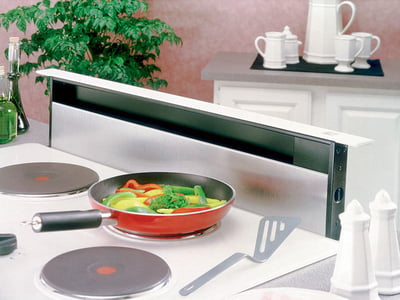
The downdraft vent is most commonly used to vent gas and electric cooktops and ranges in islands and peninsulas where it can be difficult to install overhead ventilation. These will usually have a pop-up vent built into the counter behind the cooktop that is about 3" by 30"/36" wide, to match the width of the appliance.
The blower assembly is located under the counter against the back wall of the cabinet. The vent rises up about 7 inches above the cooktop to capture the smoke, steam, and grease, and send it outside. These usually vent down through the floor then to the outside. This is not the most efficient way to vent since smoke and heat rise, so both the position of the vent (next to rather than above the stovetop) and the ductwork (which must pull air down and out rather than up and out) is not ideal.
Downdraft ranges with a downdraft vent built-in used to be very popular, but today there are very few options on the market, and soon they may disappear entirely. If you're looking to replace a downdraft range, your options are:
-
Convert to a cooktop with a stand-alone pop-up ventilation system - Stand-alone downdraft vents require space under your cabinets for the blower and other parts and can cost $1,000+. Depending on the area there may not be room for both the oven and the blower assembly to fit under the counters. You may have to install a wall oven elsewhere as well.
-
Install a ductless or recirculating range hood - This may be the best option if the cost of installing new ducting through the wall or ceiling is daunting. You can replace your downdraft range with a range of your choice and still have some filtering of the air.
-
Install a vented range hood - The best option overall, especially for pro ranges or people who cook often, but it can also be the most expensive.
Under-Cabinet Range Hoods
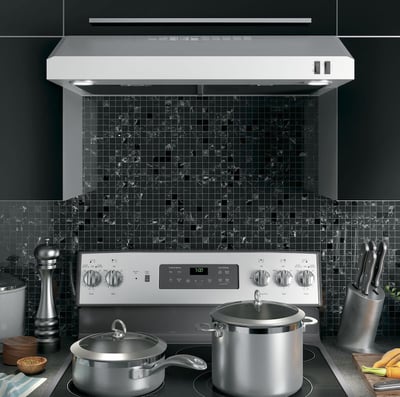
Under-cabinet range hoods require a cabinet above the range to which they will attach. They can be vented directly out the back or up through the cabinet. This style is also commonly available as convertible or recirculating. These range hoods are compact and very popular, and this style of hood tends to have the lowest prices available. Some are also available in a "pro range hood" canopy style that is larger and doesn't blend in with the cabinetry as much. They can be as little as $50, but most are around $150 and up.
Built-in range hoods hidden under cabinetry paneling are called "power packs" or "inserts" and are usually in the $400+ range.
Chimney Hoods
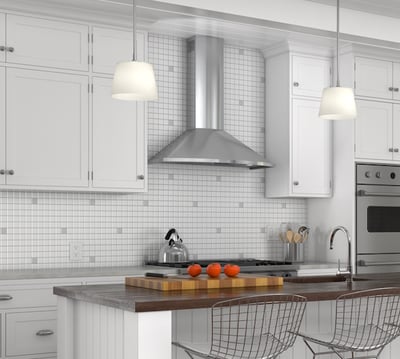
Chimney style range hoods can be found in wall mount and island mount styles. They have a wide base and a long decorative "neck" or chimney enclosure. They can be vented through a wall or up through the roof. Some chimney hoods can be converted to ductless operation. These models typically start at around $500 for wall mounted styles. Styles include a flared pyramid-shaped base, flat bases and modern curved canopies made from glass.
Wall Mounted Range Hoods
Wall-mounted range hoods can be mounted to the wall without the support of a cabinet above. These are usually chimney style hoods with a flared base. The wider base offers better coverage of the cooktop area and they have a distinct aesthetic appeal. They usually vent through an exterior wall behind them, and the side facing the wall is unfinished. They start at around $500, with nicer, higher-end models in the range of $1,000 and up. Many professional range hoods are wall-mount hoods.
Island Range Hoods

Island range hoods are designed to go over an island or peninsula where there is no wall or cabinet to support them. They are chimney-style hoods and are usually vented up through the roof. They may feature glass, copper, and other unique materials to add stylistic flair. They are finished on all sides and are more expensive than wall mounted options, starting at around $1,000.
Professional Range Hoods
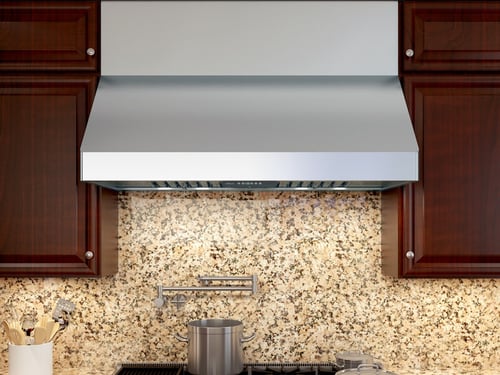
These hoods are made to have a commercial look and are usually more powerful than most other hoods. The increased power is needed to properly vent the higher BTUs of professional gas ranges. They may come in the chimney-style or a broad canopy style that is larger and more dramatic than most under-cabinet models.
They come in wall mount or under cabinet mounting options. The term "professional range hood" covers a wide variety of hood styles and options with the main feature being more powerful ventilation, typically at least 600 CFM. They are typically around $800 and up.
Calculating the CFM You Need
CFM, or Cubic Feet per Minute, measures how quickly your ventilation system can move air. There are a few ways of finding out how much CFM you need based on your range:
-
Gas Burner BTUs: 100 CFM for every 10,000 BTUs. For example, a 40,000 BTU gas range or cooktop would require a 400 CFM range hood.
-
Linear Cooking Surface: 100 CFM per linear foot of cooking surface. How wide is your stove? A typical 30" wide stove would require 250 CFM based on this measure.
Other factors:
-
Island hoods require extra CFM for cross drafts - so the linear foot measure should be 150 CFM per linear foot rather than 100. Add another 100 CFM for a professional gas range.
-
If you rarely use high heat on your stovetop (for wok stir-fry, for example), a lower CFM range hood may work fine for your needs.
-
The ideal hood height above the cooking surface varies - usually 24-32" over an electric cooking surface and 26-32" for a gas cooking surface (up to 36" if it's a professional range with high BTU output). For every 3" of increased distance, you'll need to add another 100 CFM.
-
If you need a hood over 400 CFM, consider that you'll need a supply fan, motorized damper, or other mechanism to bing in make-up air from the outside. We discuss makeup air more below in the Terms & Features section.
Ductwork length is another factor - more ductwork and more bends in this ducting also factor into how much power you need. For example, let's say every foot of ductwork diminishes the effectiveness of your hood blower by just 3%, and for each elbow in the line, another 10%. If you have a hood with 200 CFM and you have it pushing through 10 feet of duct work with one elbow, the effective power of the hood will be reduced to about 120 CFM.
This is just a rough illustration, but you can appreciate the fact that long ducting lines and elbows will certainly reduce effective CFM. There are some very complicated formulas that you can use to determine the exact figures, but it's probably better to consult a professional contractor if you want to make sure you're choosing the best range hood for your needs.
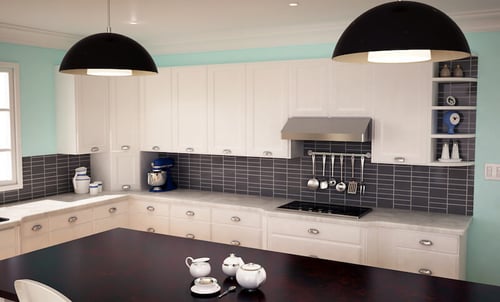
Ventilation Terms & Features
Besides CFM, here are some other terms to know when choosing a range hood or other ventilation system, listed in alphabetical order.
Blower
The fan that moves air into the duct (or through the filters and back out into the kitchen if it's a recirculating hood). They are usually located in the hood, but for quieter operation you can look for blowers located in the duct itself or externally where the ducting ends.
Damper
Prevents outside air from coming in when the fan is off. Motorized dampers can be used in vent hoods over 400 CFM to provide make-up air when the unit is on.
Ductwork
This is the piping or material used to channel the air from your hood to the outside. Using the proper duct size and installing it properly can make your hood operate better and quieter. The longer the ducting, the more powerful blower you will need.
Filter
Most hoods have aluminum filters to capture the grease from the air. These filters can be cleaned very easily, increasing the efficiency of the hood. Ductless hoods require another filter to capture smoke and odors and prevent them from being sent back into the room - charcoal filters are one option. These secondary filters will need to be changed periodically in order for the hood to operate properly.
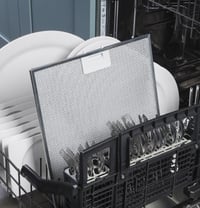
Heat sensor
Some hoods come with thermostats that will turn on the hood automatically at high speed when higher than normal heat is detected.
Hood inserts and power packs
These are the functioning parts and controls that can be installed in a custom-made hood enclosure that is designed to match your kitchen cabinets. This will usually require the purchase and installation of a hood liner as well.
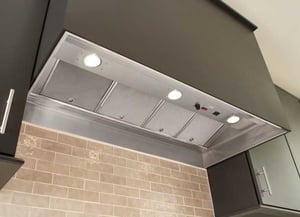
Lighting
Hoods also provide lighting for the cooking surface and surrounding counter. You'll typically see halogen or LED lighting, and some hoods may do a better job at task lighting than others. Most hoods offer at least two brightness settings. Incandescent bulbs are less common. Halogen lights tend to get hotter than LEDs when left on for an extended period of time and are less energy efficient - if you plan to use your range hood for supplemental kitchen lighting or leave it on as a night light, LEDs may be a better option. Otherwise it's a toss-up - just check out the lighting in person to see how bright the light is and what color it is. 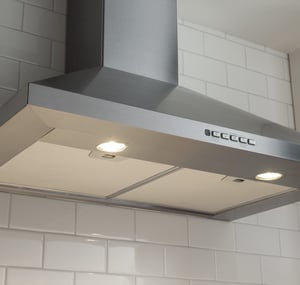
Make-up air
Whenever a range hood is in operation, air pressure is being removed from your home and has to be replaced. Air is replaced through cracks and crevices in the walls, doors, etc. New homes are insulated better and are more air-tight than older homes, so you need a professional to plan the air replacement properly and build a system suitable for your home that is within the allowable guidelines set by your state or the federal government. The generally accepted rule is that any hood with 300 CFM or more will require make-up air, but this is not necessarily the case in all homes. Make-up air kits are available from most hood and ventilation manufacturers, making it easier to provide the correct amount of make-up air for your home.
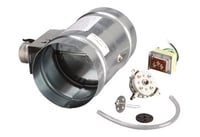
Roof cap
A roof cap attaches to the roof of your home, doing the same job as a wall cap. Roof caps are designed to allow you to vent straight up through the roof of your home. This method of venting is not as efficient and is usually used if it is the only way to get to the outside with your ductwork.

Sump
The inverted area around the rim of a range hood's canopy that collects fumes until the fan can exhaust them. Ideally it should be at least 1" deep.
Sones
This is a measurement of the noise level of a hood or ventilation system. The lower the sone rating, the quieter the hood will be. Proper venting can affect the noise level: in-line blowers in the ductwork or an external blower can reduce operation noise.
-
1 sone = 28 dB (a whisper)
-
2 sones = 38 dB
-
3 sones = 44 dB (rustling leaves or soft music)
-
4 sones = 48 dB
-
6 sones = 54 dB (a quiet office)
-
7 sones = 56 dB
-
8 sones = 58 dB
-
9 sones = 60 dB (normal conversation)
-
10 sones = 62 dB
Since 60 decibels is about the sound level that a conversation takes place, sones around that level will be intrusive. However, if the vent hood only reaches that noise level when running on "high" or a "boost" setting, it should be running at that power level for relatively short amounts of time.
Wall cap
A wall cap is an end cap for the ducting that is attached to the outside wall of the home. A good wall cap will have a screen to keep bugs and birds out of the ducting and a spring-loaded flapper that will allow air to flow out but will close to prevent outside air from entering your home through the vent.
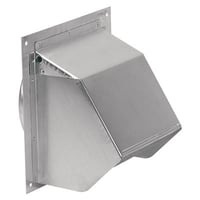
How to Compare Options - Find the Best Model for Your Needs

Is a cheap ductless or vented hood in the range of $49 to $129 right for you? These models typically offer 160-200 CFM and come with task lighting. Recirculating vents in this price range won't do a great job of venting and keeping the air in your kitchen clean and odor-free. A vented hood in this price range will do a fair job of venting as long as it doesn't have to push through a lot of ductwork to get to the outside. OTR microwave ovens do a similar job of venting and lighting.
If you only turn on the hood when you burn toast or when absolutely necessary, a cheap hood or OTR will look good in your kitchen and serve your needs. If you are looking for better performance, better lighting, and quieter operation - or you want the look of a chimney hood or other alternative style, you'll need to step it up a little!
The power of the fan is one of the most important things to consider when buying a hood. Installation location and the amount of ductwork will help you determine the amount of power you will need. Every foot of ductwork and every elbow that the fan will have to push air through will affect the efficiency of your hood!
You may need a hood over 300 CFM if you do a lot of stovetop cooking in general, but especially for...
-
Stir-frying
-
Wok cooking
-
Boiling
Make-up air systems are required by law in some cases, so consult with your builder or contractor to determine if this is needed.
Lighting is another factor. The type (halogen or LED) and location of the bulbs can impact the overall brightness and effect. LEDs are usually found on hoods in higher price ranges.
The sound level (sones) is another consideration. If the hood is in operation when you're cooking and sometimes when you're eating, you want it to operate at an acceptable noise level.
What do the controls look like? Where are they placed? The control style and functions can impact the looks and ease of use of your range hood. Some hoods also come with a remote control option.
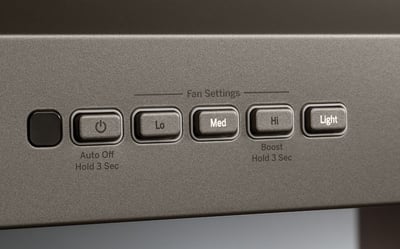
Final Thoughts
Here is what you need to know before you go into the store:
If you are replacing a hood, you should know if your old hood vents to the outside or recirculates back into the kitchen. If it is vented outside:
-
Does it vent up through the cabinets or directly out the back of the hood?
-
Approximately how much ducting is there?
If you are building or remodeling, you should know the location of the hood, the ducting arrangement, and the size and style of hood that you want.
You will also need to know...
-
How wide the opening is where the hood will be mounted
-
How wide the stove is
-
Your budget for this purchase
-
The most important features you would like your new hood to have, including the style and installation type (wall mounted, island mounted, etc)
When you are replacing a range hood, there are a couple more factors to consider, such as:
-
Should you replace your vented hood's old wall or roof cap? Inspect the old cap and make sure that the flapper is working, opening to let the vented air out and closing so as not to let outside air into the house. A bad wall cap can be very inefficient.
-
Are you getting a recirculating range hood? Consider purchasing an extra set of filters so that you will have them on hand when they need to be changed.
-
Consider purchasing compatible light bulbs - Most hoods do not come with the bulbs.
There are specialty brands for ventilation as well as mainstay appliance brands. If you are looking to get a matching appliance suite, consider a matching range hood from the same brand. Specialty brands like XO Ventilation, Zephyr, and Broan are some of our top-sellers offering a lot of options. You can find these specialty brand hoods starting in the $200 range, with Zephyr offering a lot of high-end choices in the $1,200+ range.
Like what you see here? Download the free PDF version of this buying guide and take it with you anywhere!


